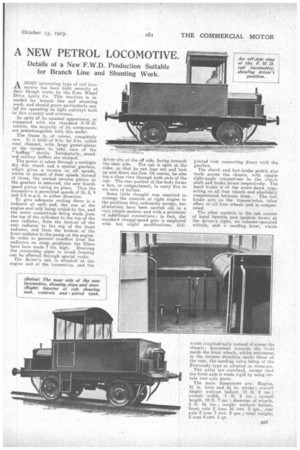A NEW PETROL LOCOMOTIVE.
Page 9

If you've noticed an error in this article please click here to report it so we can fix it.
Details of a New F.W.D. . Production Suitable for Branch Line and Shunting Work.
XiA MOST interesting type of rail locomotive baa been built recently at their Slough works by the Four Wheel Drive Lorry Co. This machine is intended for branch line and shunting work, and should prove particularly useful for operating on light railways both
• in this country and overseas.
In spite of its unusual appearance, as compared with the standard F.W.D. vehicle, the majority of its components are interchangeable with this model. The frame is, of course, completely new. It is built of 9-in. by 3-in. rolled , steel channel, with large gusset-plates at the corners to take . care of the buffing " shocks, Incidentally, standard railway buffets are utilized.
The power is taken through a multiple dry disc clutch and a special gearbox, Which gives a reverse on all speeds, whilst to permit Of four speeds instead of three, the normal reverse pinion in the gearbox is removed, the new fourth speed pinion taking its place. Thus the locomotive is permitted speeds of 16, 8, 4 and 2.8 m.p.h. in either direction.
To give adequate cooling there is ,a radiator at each end, the one at the engine end only being cooled by fan, and the water connections being made „from the top of the cylinders to the top of the rear radiator, from. the bottom of the rear radiator to the top of the front. radiator, and from the bottom of the front radiator to the pump on the engine. In 'order to prevent, overflow from the radiators on steep gradients the filleis have been made 7 ins. high. Draining the connecting pipes to avoid freezing can be effected through special cocks.
The driver's cab is situated at the engine end of the locomotive, and the driver sits at the off side, facing towards the near side. The cab is open at the sides, so that he can lean out and look up and down the line. Of course, he also has a clear view through both ends 01 the cab. The rear portion of the body forms a box, or compailment, to carry five to six tons of ballast.
Some little thought was required to arrange the controls at right angles to the positions they ordinarily occupy, but alterations have been carried out in a, very simple manner and with a minimum of additional connections ; in fact, the standard change-speed gear is employed with but slight modifications, ball jointed rods connecting .direct with the gearbox.
The clutch and foot-brake pedals also work across the chassis, with simple right-angle connections to the clutch shaft and brake levers respectively. The hand brake is Of the screw-down type, acting on all four wheels and absolutely compensated between them. The foot brake acts on the transmission, takes effect on all four wheels and is compensated.
The other controls in the cab consist of hand throttle and ignition levers at the driver's right, an exhaust-operated whistle, and a sanding lever, which iorkS longitucknally instead Of across the chassis ; movement towards the front sands the front wheels, whilst movement in the reverse direction sands those at the rear, the sanding valve being of the Everready type as adopted on tramcars. The Axles are standard, except that the front axle is made rigid by using certain rear-axle parts.
The main 'dimensions are: Engine, 43 in. bore and .% in. stroke; overall height without ballast, 11 ft: 2 ins overall width, • 7 ft. 2 ins. ' • overall length, 18 ft.. 7 ins. ; diameter of wheels, 2 ft. 9i ins. ; weight without ballast, front axle 2 tons 16 Cwt. 3 qrs., rear axle 2 toms 7 cwt. • 2 qrs: ; total weight, 5 tons 4 cwt. 1 qr.






























